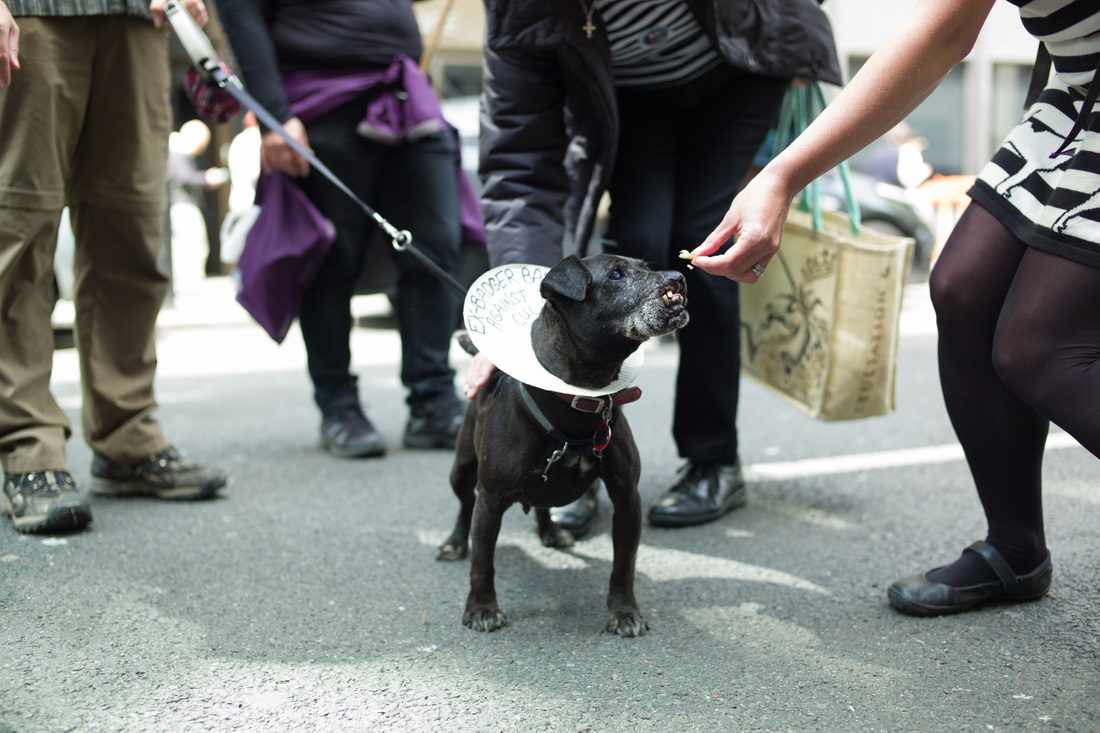Ex-Badger Baiter Against the Cull, 1 June 2013 (2013)
"Ex-Badger Baiter Against the Cull, 1 June 2013 (2013) is a new, previously unseen work. Drawing upon the posthuman strategies of Jacques Derrida and Donna Haraway, it forms part of my on-going, ecocritical investigation, now in its third year, into the nature of anthrozoological (or animal-human) encounter.
Concentrating on domestic animals, the practice has taken on many forms. Take Me To The Kittens! (2012) appropriates the anthropocentric editorial principles and aesthetic sensibilities of classic twentieth-century photojournalism, to document the lives of stray cats in Morocco. Any human presences are reduced to secondary shapes and an alternate reality for cats is revealed. THIS WAY, PUPPIES! (for a shoe filled with water) (2012) repeats this strategy with stray dogs. While Kittens! is largely a celebration of cat life, PUPPIES! is freighted with an explicit sense of political urgency. An accompanying narrative text elides the Moroccan landscape with the exhibition space in order to draw attention to the cruel and ineffectual dog culling policies of the Moroccan government. A third project, dOGUMENTA (13) (2012), further explores the possibilities of animals as political agents, here, specifically, within a contemporary art context. The photographs document the first Multispecies dTour walk, conducted by search-and-rescue dogs, around dOCUMENTA (13), the most important contemporary art festival in the world. The assumed primacy of human artists and art is put on hold as the dogs lead spectators to their favourite places to urinate, sniff, bathe and drink. Entire art installations become incidental, significant only insofar as they are of interest to the dogs themselves. Roussillon Pets (2013) swerves closest to everyday, snapshot photography. Images of the pets that have moved into a new housing estate are presented in used frames donated by new residents, and displayed in the estate’s sumptuously decorated show home. The show home is stripped of its commercial function; pets stand in for their owners and, through them, the fledgling community that is being developed is glimpsed.
The various concerns of these earlier projects come together in Ex-Badger Baiter Against the Cull. This was taken on a day when thousands of animal lovers descended on the capital for the London Against the Badger Cull rally, a public, last-ditch attempt to prevent a government-authorised badger cull in the South West of England. The ex-badger baiter’s appearance speaks of the violence done to him. For all of his apparently ferocious looks and intimidating build, the photograph’s animal-centric point of view cuts through widely held prejudices about dangerous dogs. He looks positively expectant while one woman leans forward to stroke his back; another woman, on the right of the frame, feeds him with her fingers. In the glowing light, with a crucifix glinting above his head, and a disposable paper plate around his neck that resembles a halo, he presents as somehow saintly or Messianic. The words written on the plate are, of course, not his own. They are written by his owner, but the dog stands in for his owner and, with his direct contact with badgers, he becomes a bridge between the human demonstrators and the animals that they act on behalf of. The art status of the photograph, presented in white cube space of the gallery, is momentarily suspended, replaced, instead, by a call for political action, which is unequivocal."












